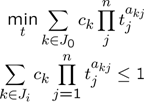Geometric programming
 This
example requires MOSEK,
GPPOSY or
fmincon This
example requires MOSEK,
GPPOSY or
fmincon
Nonlinear terms can be defined also with negative and non-integer powers.
This can be used to define geometric optimization problems.

Geometric programming solvers are capable of
solving a sub-class of geometric problems where c≥0
with the additional constraint t≥0,
so called posynomial geometric programming. The following example is
taken from the MOSEK manual. (note,
the positivity constraint on t
will be added automatically)
t1 = sdpvar(1,1);
t2 = sdpvar(1,1);
t3 = sdpvar(1,1);
obj = (40*t1^-1*t2^-0.5*t3^-1)+(20*t1*t3)+(40*t1*t2*t3);
F = set((1/3)*t1^-2*t2^-2+(4/3)*t2^0.5*t3^-1 < 1);
solvesdp(F,obj);
|
If the geometric program violates the posynomial assumption, an error
will be issued.
solvesdp(F + set(t1-t2 < 1),obj)
Warning: Solver not applicable
ans =
yalmiptime: 0.0600
solvertime: 0
info: 'Solver not applicable'
problem: -4
|
YALMIP will automatically convert some simple violations of the
posynomial assumptions, such as lower bounds on monomial terms and
maximization of negative monomials. The following small program maximizes
the volume of an open box, under constraints on the floor and wall area,
and constraints on the relation between the height, width and depth
(example from
[S. Boyd, S. Kim, L. Vandenberghe, A. Hassibi]
).
sdpvar h w d
Awall = 1;
Afloor = 1;
F = set(0.5 < h/w < 2) + set(0.5 < d/w < 2);
F = F + set(2*(h*w+h*d) < Awall) + set(w*d < Afloor);
solvesdp(F,-(h*w*d))
|
The posynomial geometric programming problem is not convex in its
standard formulation. Hence, if a general nonlinear solver is applied to
the problem, it will typically fail. However, by performing a suitable
logarithmic variable transformation, the problem is rendered convex.
YALMIP has built-in support for performing this variable change, and solve
the problem using the nonlinear solver
fmincon. To invoke this module in
YALMIP, use the solver
tag 'fmincon-geometric'.Note that this feature mainly is intended for the
fmincon solver in the MathWorks Optimization Toolbox.
It may work in the
fmincon solver in
TOMLAB, but this has not
been tested to any larger extent.
t1 = sdpvar(1,1);
t2 = sdpvar(1,1);
t3 = sdpvar(1,1);
obj = (40*t1^-1*t2^-0.5*t3^-1)+(20*t1*t3)+(40*t1*t2*t3);
F = set((1/3)*t1^-2*t2^-2+(4/3)*t2^0.5*t3^-1 < 1);
solvesdp(F,obj,sdpsettings('solver','fmincon-geometric'));
|
 The current
version of YALMIP has a bug that may cause problems if you have convex
quadratic constraints. To avoid this problem, use The current
version of YALMIP has a bug that may cause problems if you have convex
quadratic constraints. To avoid this problem, use
sdpsettings('convertconvexquad',0). To avoid some other known
issues, explicitly tell YALMIP that the
problem is a geometric problem by specifying the solver to 'gpposy', 'mosek-geometric'
or 'fmincon-geometric'.
 Never use the commands sqrt and cpower when working with
geometric programs, i.e. always use the ^ operator. The reason is
implementation issues in YALMIP. The commands sqrt and cpower
are meant to be used in optimization problems where a conic model is
derived using convexity propagation, see
nonlinear operators.
Never use the commands sqrt and cpower when working with
geometric programs, i.e. always use the ^ operator. The reason is
implementation issues in YALMIP. The commands sqrt and cpower
are meant to be used in optimization problems where a conic model is
derived using convexity propagation, see
nonlinear operators.
Generalized geometric programming
Some geometric programs, although not given in standard form, can still
be solved using a standard geometric programming solver after some some
additional variables and constraints have been introduced. YALMIP has
built-in support for some of these conversion.
To begin with, nonlinear operators can be used also in geometric
programs, as in any other optimization problems (as long as YALMIP is
capable of proving convexity, see the nonlinear
operator examples)
t1 = sdpvar(1,1);
t2 = sdpvar(1,1);
t3 = sdpvar(1,1);
obj = (40*t1^-1*t2^-0.5*t3^-1)+(20*t1*t3)+(40*t1*t2*t3);
F = set(max((1/3)*t1^-2*t2^-2+(4/3)*t2^0.5*t3^-1,0.25*t1*t2) < min(t1,t2));
solvesdp(F,obj);
|
Powers of posynomials are allowed in generalized geometric
programs. YALMIP will automatically take care of this and convert the
problems to a standard geometric programs. Note that the power has to be
positive if used on the left-hand side of a <, and negative otherwise.
t1 = sdpvar(1,1);
t2 = sdpvar(1,1);
t3 = sdpvar(1,1);
obj = (40*t1^-1*t2^-0.5*t3^-1)+(20*t1*t3)+(40*t1*t2*t3);
F = set(max((1/3)*t1^-2*t2^-2+(4/3)*t2^0.5*t3^-1,0.25*t1*t2) < min((t1+0.5*t2)^-1,t2));
F = F + set((2*t1+3*t2^-1)^0.5 < 2);
solvesdp(F,obj);
|
To understand how a generalized geometric program can be converted to a
standard geometric program. the reader is referred to
[S. Boyd, S. Kim, L. Vandenberghe, A. Hassibi]
Mixed integer geometric programming
The branch and bound solver in YALMIP is built in a modular fashion that makes it
possible to solve almost arbitrary convex mixed integer programs. The
following example is taken from
[S. Boyd, S. Kim, L. Vandenberghe, A. Hassibi].
To begin with, define the data for the example.
a = ones(7,1);
alpha = ones(7,1);
beta = ones(7,1);
gamma = ones(7,1);
f = [1 0.8 1 0.7 0.7 0.5 0.5]';
e = [1 2 1 1.5 1.5 1 2]';
Cout6 = 10;
Cout7 = 10;
|
Introduce symbolic expressions used in the model.
x = sdpvar(7,1);
C = alpha+beta.*x;
A = sum(a.*x);
P = sum(f.*e.*x);
R = gamma./x;
D1 = R(1)*(C(4));
D2 = R(2)*(C(4)+C(5));
D3 = R(3)*(C(5)+C(7));
D4 = R(4)*(C(6)+C(7));
D5 = R(5)*(C(7));
D6 = R(6)*Cout6;
D7 = R(7)*Cout7;
|
The objective function and constraints (notice the use of the
nonlinear operator max in the
objective).
% Constraints
F = set(x > 1) + set(P < 20) + set(A < 100);
% Objective
D = max((D1+D4+D6),(D1+D4+D7),(D2+D4+D6),(D2+D4+D7),(D2+D5+D7),(D3+D5+D6),(D3+D7));
|
Solve!
solvesdp(F+set(integer(x)),D)
double(D)
ans =
8.3333
|
An alternative model is discussed in the paper, and is just as easy
to define.
T1 = D1;
T2 = D2;
T3 = D3;
T4 = max(T1,T2)+D4;
T5 = max(T2,T3) + D5;
T6 = T4 + D6;
T7 = max(T3,T4,T5) + D7;
D = max(T6,T7);
solvesdp(F+set(integer(x)),D)
double(D)
ans =
8.3333
|
|
